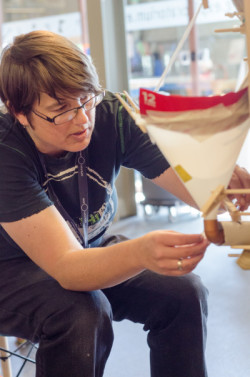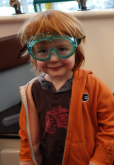
I found myself on the floor of the Tinkering Studio in The Exploratorium on a Tuesday morning in autumn 2014, paired with a high school math teacher and armed with the task of making a marble go as slowly as possible. I was invigorated: I had a partner, I had a goal, and I had the resources of The Exploratorium to create a marble machine that would require us to grapple with gravity, slope, velocity, angle, material precision, and create a system designed to slow down a marble. I, of course, didn’t realize these curricular connections at the time. I was just simply excited to tinker, build, and test materials that could assist in challenging a marble’s natural inclination to roll down an incline.
For two hours, my partner and I played with and tested materials such as a peg board, pegs, ramps, cardboard, paper, pipe cleaners, funnels, tape, string, and metal lids. During this time, I found myself laughing, high-fiving my partner when things went well, and clenching my fists when we were not successful. During these moments of nuanced success and iteration, I started to remember skills that I was good at: I was always the one to fix the wobbly table with any available materials; I had played competitive softball for years and my steady hands that helped me grab line drives and put down the bunt now helped me strategically place a small copper pipe on a ramp to slow our marble; and I could collaborate with a partner that I knew had more expertise on the topic and know that I would still be able to contribute to the task at hand.
I love the freedom and exploratory nature of making. While the Maker Movement is often recognized in the popular press for its cool, innovative tools and low-cost, personalized gadgets, I believe that the love of making and the love of learning are the real drivers of this cultural movement and educational approach.
I have witnessed first hand how making and maker-based activities impact learners, both young and old. As a mother of two children under the age of five, making is an everyday activity for our family. I love to open a can of Play-Doh and see what they create. I also love to learn from them and their making experiences, whether it is my daughter’s iterative intensity at rolling her marble down the ramp as fast as possible or my son sharing his technique for wearing safety glasses. These maker experiences further their love of learning and our love, as a family, of learning together.
At Maker Ed, my role as the Education Community Manager is to strengthen connections across a national network of maker educators and support existing regional communities of maker educators. It is an honor to join the Maker Ed team and further the goal of “Every Child a Maker.”


